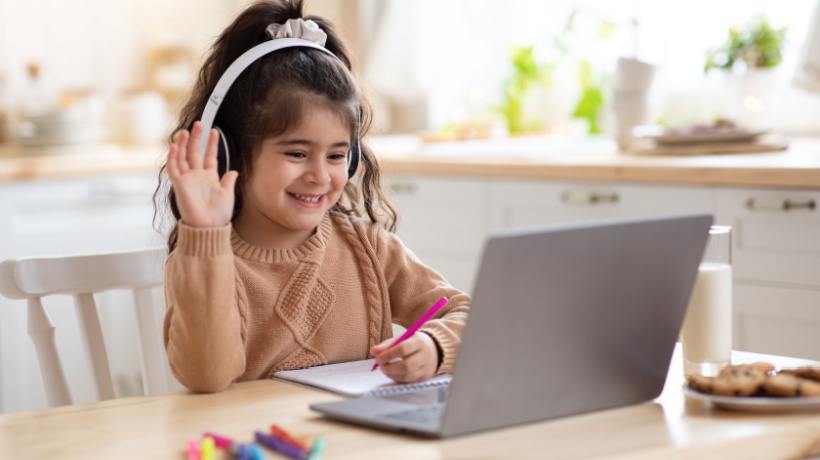The Importance Of Communication When Children Use eLearning Platforms
We know that children learn more effectively when interacting with their teachers or classmates. The eLearning experience can sometimes be lonely, especially for kids who are used to a classroom environment. So, communication helps them stay connected to their peers and teachers, creating a sense of community. Plus, it is an active process and prompts the children to participate in discussions and projects. By sharing ideas and working together, children can gain a deeper understanding of the learning material. Also, let’s not forget that, for some kids, communicating online is less intimidating than speaking up in a classroom, and it helps them build their confidence and express their opinions more comfortably. Today, many eLearning platforms encourage this by offering features that help foster communication skills. However, there are some things you can do as a teacher to encourage communication in kids’ eLearning platforms. Here are 7 tips to help you get started.
7 Ways To Increase Communication Opportunities For Kids During eLearning
1. Clear Communication Guidelines
It’s important that younger learners have clear instructions for how communication will take place on the eLearning platform your school has chosen. Of course, those instructions should be addressed positively so as not to discourage your students. Don’t forget that kids can be easily intimidated by strict rules and authoritarian language. As a teacher, you should clearly outline what kind of language is acceptable and how students should address each other or you. Also, you should be specific about which topics are appropriate for discussion.
2. Interactive Tools
Many kids’ eLearning platforms have interactive tools to aid the learning process. Use these tools yourself, like chat rooms, discussion forums, and video calls, to encourage your students to do the same. Through these tools, children can share their thoughts, ask questions, and respond to each other’s comments to enrich the educational experience.
3. Group Projects
Group projects can be a fun and meaningful way to encourage your students to communicate with each other. You can even allow them to choose their own teammates to streamline their collaboration. Just make sure that they don’t form cliques and branch out socially every now and then and learn more about other classmates.
4. Peer-To-Peer Feedback
Encourage students to provide feedback to each other. You can assign them peer reviews or group discussions where learners can share their work and provide constructive comments. This will teach them to offer their insights tactfully and build their social skills by using the right tools in eLearning platforms to convey their thoughts.
5. Icebreaker Activities
Mornings can be hard for kids, and they often can’t concentrate at the beginning of their classes. After all, who would want to leave the comfort of their bed to log in to a “boring” lesson? You can make the first hour of each class more engaging by using icebreakers to encourage them to be more talkative. It will also help students get to know each other. For example, you can play trivia games or prompt them to share their pets’ photos.
6. Be More Active
As a teacher, you should be actively engaged in facilitating communication among students. This means that you can monitor their online discussions to ensure they are following the guidelines you set. You should also give them constructive feedback and encourage them to participate in class and not be afraid or hesitant to share their questions and thoughts. Make sure they know you’re always there for them when the need arises or that they can send you a message on the platform about anything that’s troubling them, whether it’s school-related or not.
7. Celebrate Successes
Finally, don’t forget to celebrate their successes in effective communication. When you see the kids working together, let them know on the spot. Recognize their efforts and highlight how important it is that they can effectively talk with each other and form meaningful relationships. This can encourage more communication and collaboration between them in future activities.
What To Look For In A Kids’ eLearning Platform
User-Friendly Interface And Accessibility
A user-friendly interface is one of the most essential aspects in a kids’ eLearning platform. Students should be able to navigate through it without help from an adult. This can include large buttons, simple instructions, and a clear layout of the learning material. Most importantly, children’s eLearning platforms should be designed to accommodate all types of learners, including those with special needs. This refers to accessibility features like closed captioning, audio descriptions, and adjustable font sizing.
Interactive And Engaging Content
Kids are more likely to actively participate in the experience if it’s interactive and appealing. So, try incorporating videos, animations, quizzes, and other interactive activities when designing lessons. Adding games with gamification elements such as reward systems or progress bars can also motivate kids to complete the course and give it their all.
Parental Controls
Parents must be able to monitor their child’s performance at all times. Your eLearning platform should include features accessible only by parents, with insights into the student’s progress, and the ability to set time limits and have complete control of certain features. Also, parents should be able to communicate with the teacher regarding updates, concerns, or questions.
Conclusion
Effective learning programs for children should encourage communication among students and teachers through specific tools and give space for teachers to use their creativity to add more collaborative initiatives. This prepares young students for future academic and professional pursuits and helps them achieve their educational goals. First and foremost, it’s crucial to select eLearning platforms that create a safe and engaging environment to host the kids’ educational journeys.

